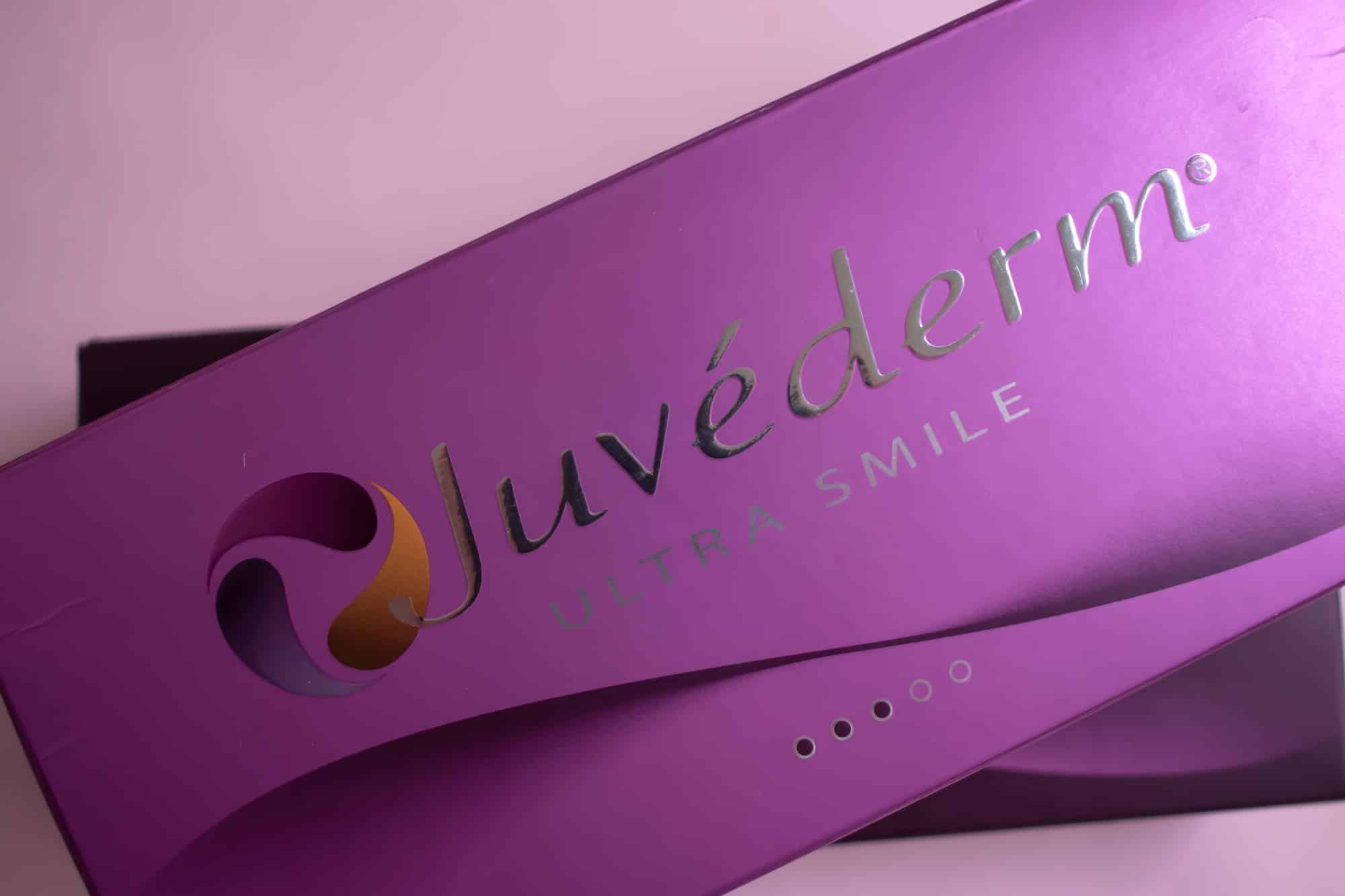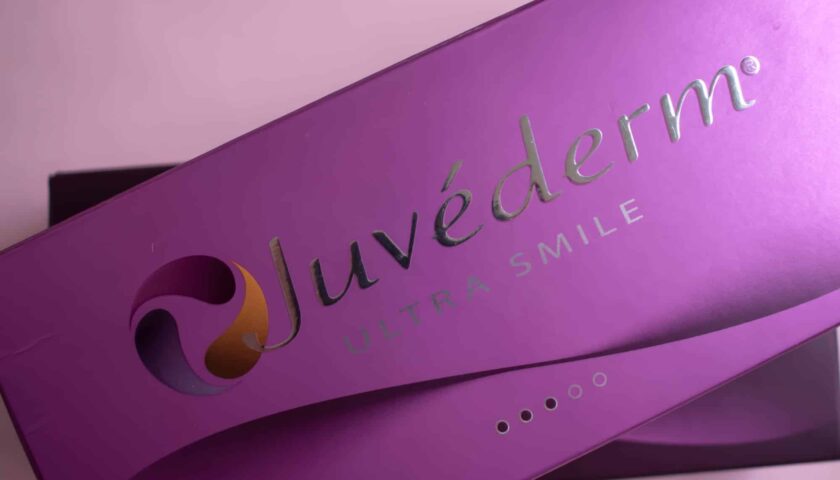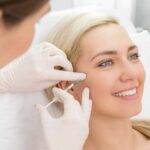
Juvederm, a brand of hyaluronic acid-based dermal fillers, offers a range of products to address specific cosmetic concerns. Juvederm helps restore youthful contours and enhance facial features by adding volume and smoothing wrinkles. This article explores the different Juvederm products, how they work, and what Juvederm is used for. It will also look at the treatment procedure, Juvederm ingredients, and the potential risks and side effects when using these filters.
What Is Juvederm?
Juvederm is a hyaluronic acid-based dermal filler brand. The Juvederm manufacturer produces several types of hyaluronic acid-based fillers – Ultra, Ultra Plus, Vollure, Volbella, and Voluma – varying in thickness and elasticity. The product is mainly based on formulations of stabilized hyaluronic acid with added lidocaine used as a local anesthetic.
Denser and less elastic fillers are used in shaping the cheekbones and jaw, thicker fillers add volume to the cheeks or lips, and thinner fillers help moisturize an area without changing its volume or structure (such as under the eyes and lips). Since hyaluronic acid is naturally produced and metabolized by the body, the filters are generally well accepted, and the body slowly metabolizes the product over time.
The Juvederm product line is designed to meet the specific needs of patients depending on the area of treatment and the volume increase required:
- Juvederm Volbella is used for the lips and lip area to add light volume and smooth out vertical lip lines.
- Juvederm Ultra is also designed for the lips and the surrounding tissue but provides more fullness than Juvederm Volbella.
- Juvederm Voluma is designed for the cheek area. It helps improve cheek volume, creates a lifting effect, and assists with molding the cheek contours.
- Juvederm Vollure is also suitable for moderate to severe wrinkles or folds but may last longer than the other Juvederm formulations.
How Does Juvederm Work?
When Juvederm is injected, the hyaluronic acid particles attract and bind to water molecules, creating a gel-like substance. This gel adds volume to the treated area, filling in wrinkles, lines, and hollowed spots. Additionally, it hydrates and plumps the skin, making it smoother and creating a more youthful appearance.
The specific formulation of Juvederm products may vary depending on the desired effect and the treated area. For example, some are designed for fine lines and delicate areas, while others are more suitable for deeper lines and areas with more volume loss.
The effects of Juvederm are temporary, as the hyaluronic acid eventually breaks down and is absorbed by the body over time. The duration of the results can vary (6-12 months typically), depending on the product chosen and individual factors such as the patient’s metabolism and lifestyle.
Approved Treatment Areas
Juvederm has been approved by regulatory authorities, such as the U.S. Food and Drug Administration (FDA), for various areas of treatment. Specifically approved indications may vary depending on the country and the particular product within the Juvederm line. However, here are some common areas of treatment for which Juvederm is often used:
- Nasolabial Folds;
- Marionette Lines;
- Lips and Perioral Area: Juvederm can be used to enhance lip volume, define lip contours, and reduce fine lines around the mouth;
- Cheeks and the midface area: Juvederm Voluma is designed to add volume and lift to the midface area and cheeks, helping restore youthful contours.
- Vertical Lip Lines: fine lines that appear around the lips and can be targeted with Juvederm;
- Tear Troughs: Juvederm Volbella may be used to address the hollowed area under the eyes, known as tear troughs, by adding volume and reducing the appearance of dark circles or sunkenness.
Juvederm Treatment Procedure
The Juvederm correction procedure takes up to an hour, depending on the products used and a few other factors. Additional anesthesia is not performed during the injection process, as lidocaine, included in the composition, helps avoid unpleasant sensations and pain.
The use of additional anesthetic agents is possible only in the case of lip correction, as a large number of injections into the mucous membrane are required during this procedure.
A typical Juvederm treatment occurs in stages:
- Consultation, selection of the appropriate product, and its dosage;
- Cleansing the skin from dirt and cosmetics;
- Marking the skin and identifying the injection points;
- Administering the filler;
- Applying restorative products.
For maximum effectiveness and prolonged action of the products, it is recommended to undergo two procedures with a break of seven to twelve days between them.
Risks and Side Effects
Juvederm is FDA-approved for cosmetic use. This product has a very high safety profile, but it should be avoided by patients who are allergic to its components.
Contraindications
- Pregnancy or lactation;
- Allergy to hyaluronic acid;
- Autoimmune processes;
- Tendency to hypertrophic scars;
- Susceptibility to allergic complications;
- Presence of previously injected gel which has not been fully absorbed by the body
- Recent history of chemical peeling or laser skin resurfacing procedures.
Side effects after the administration of fillers are rare but may include bruising in the injection areas, skin redness, tenderness, swelling, lumps, and itching. These side effects typically subside within two to three days (up to a week at most).
Conclusion
Juvederm, a hyaluronic acid-based dermal filler brand, offers a versatile range of products to address specific cosmetic concerns. Juvederm uses the body’s natural hyaluronic acid to effectively add volume, smooth out wrinkles, and enhance facial features, providing a rejuvenated and youthful appearance.
With various formulations tailored to different face areas, Juvederm can target specific concerns such as lip volume, cheek augmentation, and reduction of facial folds. In addition, Juvederm filler treatment is generally safe and well-tolerated, with minimal side effects that typically resolve within a few days.
FAQ
What is the difference between Botox and Juvederm?
They are both used for cosmetic purposes, but it is wrong to compare Juvederm vs Botox since they work in different ways and target different concerns. Botox temporarily relaxes muscles to reduce dynamic wrinkles caused by muscle movement, while Juvederm is a dermal filler that adds volume and fills in wrinkles and lines.
How long does Juvederm last for?
Juvederm’s duration varies depending on the product and individual factors but typically lasts from several months to over a year.
What is Juvederm made from?
Juvederm is based on stabilized hyaluronic acid in different concentrations (depending on the product) and a small dose of lidocaine that acts as an anesthetic.
Injectable aesthetics are popular due to their ability to provide noticeable results with minimal downtime compared to surgical procedures. They are versatile and can be tailored to meet individual aesthetic goals, whether it's enhancing lips, restoring facial volume, or smoothing out wrinkles. However, they should always be administered by qualified professionals to ensure safety and achieve optimal results.
Injectable aesthetics are used to enhance facial features, reduce the signs of aging, and improve overall facial symmetry and appearance.
Key types of injectable aesthetics include:
-
Dermal Fillers: These injectables are used to add volume, fill in wrinkles and folds, and enhance facial contours. They often contain substances like hyaluronic acid, collagen, or calcium hydroxylapatite, which help plump up the skin and smooth out fine lines and wrinkles.
-
Botulinum Toxin (Botox): Botulinum toxin injections temporarily relax facial muscles that cause wrinkles and lines to form. It is commonly used to treat forehead lines, frown lines between the eyebrows, and crow's feet around the eyes.
-
Collagen Stimulators: These injectables stimulate the body's own collagen production, helping to improve skin texture and firmness over time. Examples include poly-L-lactic acid (Sculptra) and calcium hydroxylapatite (Radiesse).
-
Neurotoxin Injections: Besides Botox, other neurotoxins such as Dysport and Xeomin are used similarly to reduce wrinkles and lines.





